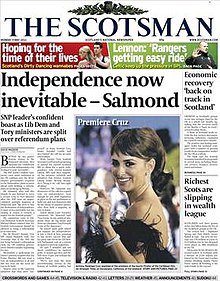Scotsman newspaper

The Scotsman cover (11 May 2011)
|
|
| Type | Daily newspaper |
|---|---|
| Format | Compact |
| Owner(s) | Johnston Press |
| Editor | Frank O'Donnell |
| Founded | 1817 |
| Political alignment | non-party, unionist |
| Headquarters | Orchard Brae House, 30 Queensferry Road, Edinburgh |
| Circulation | 19,449 (February 2017, 88.3% paid) |
| Sister newspapers | Edinburgh Evening News, Scotland on Sunday |
| ISSN | 0307-5850 |
| OCLC number | 614655655 |
| Website | scotsman |
The Scotsman is a Scottish compact newspaper and daily news website headquartered in Edinburgh. First established as a radical political paper in 1817, it began daily publication in 1855 and remained a broadsheet until 16 August 2004. Its parent company, The Scotsman Publications Ltd, also publishes the Edinburgh Evening News. As of February 2017, it had an audited print circulation of 19,449, with a paid-for circulation of 88.3% of this figure, about 14,000. Scotsman.com has an average of 97,200 visitors a day. The title celebrated its bicentenary on 25 January 2017.
The Scotsman was launched in 1817 as a liberal weekly newspaper by lawyer William Ritchie and customs official Charles Maclaren in response to the "unblushing subservience" of competing newspapers to the Edinburgh establishment. The paper was pledged to "impartiality, firmness and independence". After the abolition of newspaper stamp tax in Scotland in 1855, The Scotsman was relaunched as a daily newspaper priced at 1d and a circulation of 6,000 copies.
Their premises were originally at 257 High Street on the Royal Mile.
In 1860 they obtained a purpose built office on Cockburn Street in Edinburgh designed in the Scots baronial style by the architects Peddie & Kinnear. This backed onto their original offices on the Royal Mile. The building bears the initials "JR" for John Ritchie the founder of the company. On 19 December 1904, they moved to huge new offices at the top of the street, facing onto North Bridge, designed by Dunn & Findlay (Findlay being the son of the then owner). This huge building had taken three years to build and also had connected printworks on Market Street (now the City Art Centre). The printworks connected below road level direct to Waverley Station in a highly efficient production line.
...
Wikipedia
